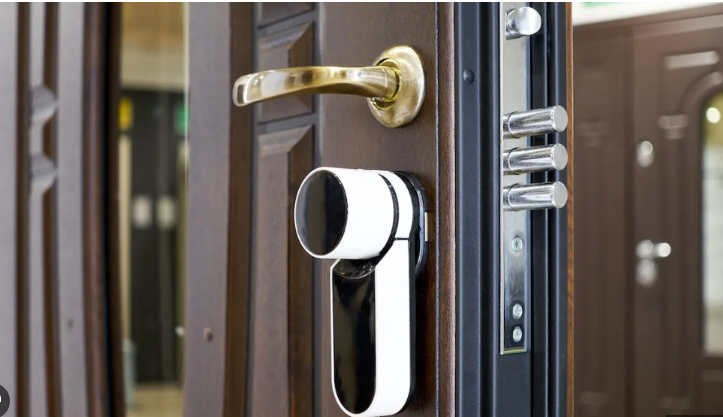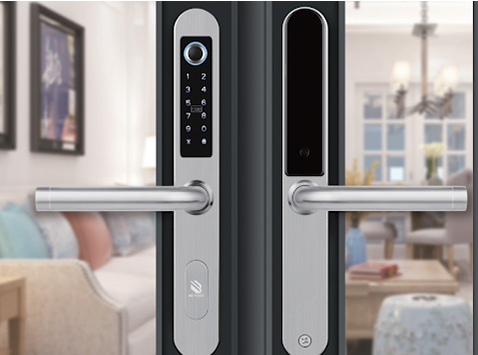As smart home technology continues to transform the way we secure our homes, many homeowners are asking, “How secure are smart locks?” The allure of keyless entry, remote access, and smart home integration makes smart locks a popular choice, but their reliance on technology raises questions about their safety compared to traditional locks. In this comprehensive guide, we’ll explore the security of smart locks, their strengths, potential vulnerabilities, and how to maximize smart lock safety through proper smart lock installation, setup, and maintenance. By the end, you’ll have a clear understanding of how secure smart locks are and how to choose the best model for your home with help from a trusted smart lock guide.
Understanding Smart Locks: How Do They Work?
To assess how secure smart locks are, it’s important to understand their functionality. Unlike traditional deadbolts that rely on physical keys, smart locks use technologies like Wi-Fi, Bluetooth, Z-Wave, or Zigbee to enable keyless entry. You can unlock your door using a smartphone app, PIN code, voice command through a smart assistant, or biometric features like fingerprint scanning. Many models also offer remote access, allowing you to control your lock from anywhere with an internet connection.
While these features enhance convenience, they introduce digital security considerations that traditional locks don’t face. To determine how secure smart locks are, we need to evaluate their security features, potential risks, and best practices for smart lock setup and maintenance.

Key Security Features of Smart Locks
Smart locks are designed with advanced security features to protect your home. When exploring how secure smart locks are, consider the following features that reputable models offer, as highlighted in a reliable best smart lock guide:
- Advanced Encryption: High-quality smart locks use military-grade encryption protocols, such as AES-128 or AES-256, to secure communication between the lock and your smartphone or smart home hub. This ensures that data transmitted during remote access or when you connect a smart lock is protected from interception.
- Two-Factor Authentication (2FA): Many smart locks support 2FA, requiring a second form of verification (e.g., a PIN or biometric scan) in addition to your app, adding an extra layer of security.
- Tamper-Resistant Design: The best smart locks are built with durable, tamper-resistant materials and meet high ANSI/BHMA ratings, making them as resistant to physical attacks as traditional locks.
- Activity Logs: Smart locks often provide real-time logs of who accesses your door and when, allowing you to monitor activity and detect unauthorized entry attempts.
- Auto-Lock and Geofencing: Features like auto-lock ensure your door locks automatically after a set period, while geofencing uses your smartphone’s location to lock or unlock the door, reducing the risk of human error.
- Tamper Alarms: Some models include sensors that trigger an alarm if someone attempts to tamper with the lock, deterring physical attacks.
These features demonstrate that smart locks can be highly secure when designed with safety in mind. However, their effectiveness depends on choosing a reputable model and following proper smart lock installation and setup practices.
Potential Vulnerabilities of Smart Locks
While smart locks offer robust security features, no device is completely immune to risks. To fully understand how secure smart locks are, let’s examine potential vulnerabilities and how to mitigate them:
- Hacking Risks: Since many smart locks rely on Wi-Fi or Bluetooth connectivity, they could be targeted by hackers attempting to intercept signals or exploit software vulnerabilities. However, strong encryption, 2FA, and regular firmware updates significantly reduce this risk.
- Weak Passwords: Using a weak or reused password for your smart lock app or associated accounts can make your lock vulnerable to brute-force attacks. Always use strong, unique passwords and enable 2FA.
- Power Dependency: Smart locks rely on batteries, and a dead battery could potentially lock you out. Most models offer excellent smart lock battery life (typically 6–12 months) and provide low-battery alerts to prevent issues.
- Software Glitches: Like any connected device, smart locks can experience software bugs that affect performance. Regular smart lock maintenance, including firmware updates, helps address these issues.
- Physical Tampering: While rare, physical attacks on smart locks are possible. Choosing a lock with a high ANSI/BHMA rating ensures it can withstand forced entry attempts.
By understanding these risks and taking proactive steps, you can ensure that your smart lock remains secure and reliable.
How to Maximize Smart Lock Security
To make your smart lock as secure as possible, follow these best practices for smart lock installation, setup, and maintenance. These smart lock tips will help you protect your home and minimize vulnerabilities:
1. Choose a High-Quality Smart Lock
Not all smart locks are equally secure. Select a model from a trusted brand with strong encryption, regular firmware updates, and positive user reviews. A comprehensive smart lock guide can help you compare features and choose a lock that prioritizes smart lock safety.
2. Ensure Proper Smart Lock Installation
Correct smart lock installation is essential for both security and functionality. Most smart locks are designed for easy DIY installation, but you must follow the manufacturer’s instructions carefully. Ensure the lock is properly aligned with your door’s strike plate and test it thoroughly after installation. If you’re unsure, hire a professional to avoid errors that could compromise security.
3. Secure Your Smart Lock Setup
When setting up your smart lock, take these steps to enhance security:
- Use a strong, unique password for the lock’s app and any associated smart home accounts.
- Enable 2FA if available to add an extra layer of protection.
- Connect your smart lock to a secure Wi-Fi network with WPA3 encryption, and avoid using public Wi-Fi for remote access.
- Follow the manufacturer’s instructions for how to pair a smart lock to ensure secure device connections.
A secure smart lock setup ensures your lock communicates safely with your devices and minimizes hacking risks.
4. Perform Regular Smart Lock Maintenance
Regular smart lock maintenance is crucial to keep your lock secure and functional. Check the smart lock battery life every few months and replace batteries promptly when low—most models provide app notifications to alert you. Keep the lock’s firmware updated to patch security vulnerabilities and ensure optimal performance. Additionally, clean the lock periodically to prevent physical wear.
5. Address Issues with Smart Lock Troubleshooting
If you encounter issues like connectivity problems or unresponsive controls, refer to the manufacturer’s smart lock troubleshooting guide. Common fixes include resetting the lock, re-pairing it with your smartphone, or checking your Wi-Fi or Bluetooth connection. Prompt troubleshooting prevents potential security gaps and ensures reliable operation.
6. Consider a Portable Smart Lock for Temporary Needs
For renters or those who need a temporary solution, a portable smart lock is an excellent choice. These locks are easy to install and remove without altering the door, making them ideal for apartments or travel. Ensure the portable lock you choose has strong encryption and reliable battery life to maintain security.

Are Smart Locks More Secure Than Traditional Locks?
When evaluating how secure smart locks are, it’s natural to compare them to traditional locks. Traditional deadbolts are vulnerable to physical attacks like lock-picking, bump keys, or key duplication, which skilled intruders can exploit. Smart locks, on the other hand, offer advanced features like encryption, activity logs, and remote monitoring, which traditional locks lack.
However, smart locks require proactive maintenance, such as monitoring smart lock battery life and updating firmware to address vulnerabilities. A high-quality smart lock with strong encryption and tamper-resistant design can be as secure as—or more secure than—a traditional lock, especially when paired with proper smart lock installation and setup. For example, a smart lock with a Grade 1 ANSI/BHMA rating offers the same physical strength as a top-tier traditional deadbolt, plus digital protections.
Smart Lock Security for Different Use Cases
Smart locks are versatile and can be tailored to various scenarios, each with specific security considerations:
- Homeowners: Choose a smart lock with advanced encryption and smart home integration for enhanced control and monitoring. Wi-Fi-enabled locks are ideal for remote access.
- Renters: A portable smart lock provides secure, non-invasive access that can be easily removed without damaging the door.
- Vacation Rentals: Smart locks allow hosts to grant temporary access codes to guests and monitor activity remotely, enhancing security for short-term rentals.
- Businesses: Commercial-grade smart locks with Z-Wave or Zigbee connectivity offer secure access control, user management, and audit trails for offices or small businesses.
Regardless of the use case, following smart lock tips like securing your Wi-Fi network and enabling 2FA ensures maximum security.
Common Myths About Smart Lock Security
Several myths about smart lock security can create confusion. Let’s debunk a few:
- Myth: Smart locks are easily hacked. High-quality smart locks with strong encryption and 2FA are extremely difficult to hack, especially when properly configured.
- Myth: Smart locks fail during power outages. Most smart locks run on batteries and include a physical key as a backup, ensuring access even without power.
- Myth: Smart locks are too complex to use securely. Modern smart locks are user-friendly, with intuitive apps and clear instructions for how to pair a smart lock and maintain it.
By choosing a reliable model and following best practices, you can dispel these myths and enjoy the benefits of a secure smart lock.
Conclusion: How Secure Are Smart Locks?
So, how secure are smart locks? When chosen wisely and used correctly, smart locks are highly secure, often offering advantages over traditional locks. Features like advanced encryption, 2FA, tamper-resistant designs, and activity logs make them robust against both digital and physical threats. By following best practices for smart lock installation, smart lock setup, and smart lock maintenance, you can minimize risks and ensure your lock remains reliable and secure.
Whether you’re a homeowner, renter, or business owner, a smart lock can enhance your security while providing unmatched convenience. For more guidance on selecting a secure model, explore this comprehensive home security tips guide to find the best smart lock for your needs. With the right precautions, a smart lock can be a safe, modern, and dependable solution for protecting your home.